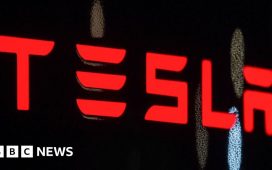Aston Martin Lagonda has been forced to pay a hefty interest rate to borrow $150m (£120m) as the maker of James Bond’s cars struggles to meet ambitious targets amid falling sales.
The luxury carmaker will pay 12% on $150m (£120m) of secured bonds until April 2022. If orders for its DBX model hit targets it has the option to issue a further $100m of secured bonds paying the same rate. However, if orders fall short it could have to pay 15%.
Russ Mould, investment director at stockbroker AJ Bell, said the high interest rates were a major red flag that investors considered the car company to be a high-risk entity.
He said the 12% rate suggested Aston Martin needed the money and had had to bow to investors’ demands.
Part of the debt is structured as a payment-in-kind (PIK) note, which means the interest is not paid regularly but rolled up and paid at maturity. Overall, payments at the end of the term are higher.
Mould said: “History tells us that companies with high debt repayment obligations, particularly those involving PIK notes, can get into real trouble in a market downturn if earnings are hit and they struggle to service the debt.”
Aston Martin said it needed the funds to give it more cash while it carried out a plan to produce seven new models in seven years. It will also use the money to pay off short-term debts and cover transaction costs.
Standard & Poor’s (S&P), a debt rating agency, cut its rating on Aston Martin deeper into non-investment, or “junk”, territory after the bond issue. S&P downgraded Aston Martin to CCC+ from B- with a negative outlook, saying it had reached the limit of debt and interest it could repay.
S&P said the negative outlook reflected the company’s high debt and spending as it faced the risk of no-deal Brexit and new tariffs on US exports. The agency said: “In addition, AML is about to launch its new DBX luxury SUV, the success of which is critical to its ambitious growth strategy and ongoing creditworthiness.”
The “second century” plan launched by Aston Martin’s chief executive, Andy Palmer, has struggled to get out of first gea. The company has been hit by rising costs, supply chain issues and a sales slump. The company swung to a £79m loss in the six months to the end of June from a £21m profit the previous year.
Aston Martin has blamed economic uncertainty and the prospect of a no-deal Brexit for poor sales in the UK and Europe. Aston Martin’s market value has plunged from £4.3bn, when it floated on the stock exchange last October, to about £1.2bn as concerns about its losses have mounted.
Mark Wilson, its chief financial officer, said: “At the [first-half] results we highlighted that we expected macroeconomic headwinds and uncertainty to continue. These circumstances require flexibility in our financing arrangements to ensure that resources are available to deliver the second century plan.”
Aston Martin said the DBX, its first sports utility vehicle, was on schedule and had been well-received at Monterey car week in August. The second batch of bonds require the company to receive 1,400 orders for the new DBX within nine months of the first $150m.












